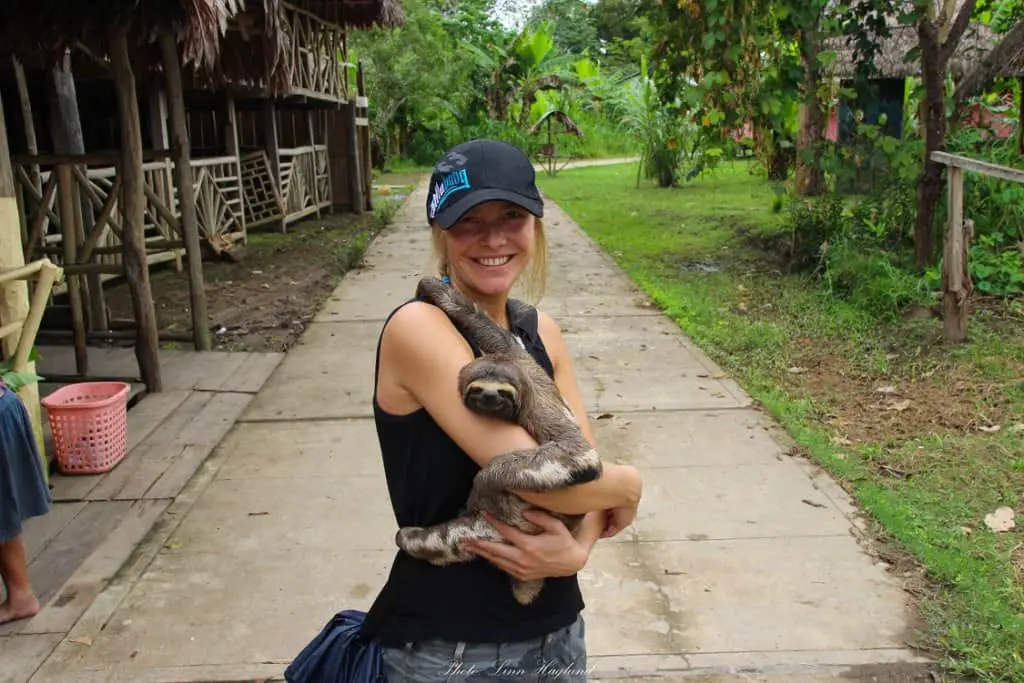In 2015, I walked into a village in the Peruvian Amazon with our local guide. I passed a house, where this woman was holding an adorable sloth in her arms and I totally fell in love with her pet. She saw my excitement and came over and handed him over to me. My enthusiasm was beyond measure! I got a picture to freeze this exhilarating travel memory forever and always.
It wasn’t before a couple of years later that I learned why you should never hold a sloth!
Whenever I look at that picture now, I get truly sad. Sad thinking about all the sloths suffering in tourism. Sad for all those travelers that do the same as I did and later realize it was harmful to the animal.
I couldn’t believe I had done it again. Unethical animal tourism without being aware of it. I couldnt other than feel stupid. I should have known better!
In this post I’ll share everything I learned about why you should never hold a sloth and how you can experience this amazingly cute creature in an ethical way.
Regardless of whether the animal was rescued or taken from the wild purposefully, we can tell you with 100% certainty that any form of direct human contact is damaging to the health of ALL sloths.
The Sloth Conservation Foundation

Why you should never hold a sloth
It does seem pretty innocent to hold a sloth. They are so adorable with their weird little hairdo and charming grin on their face.
You’ll probably hear both from individuals handing you a sloth or from rescue facilities that the sloth is used to humans so it likes to be held.
So why should you never hold a sloth? And why is it harmful to them? Sloths get extremely stressed when handled.
They normally move very slowly, thus they get tremendously stressed in an environment with a lot of changes.
Whether it’s in captivity or in the wild.
According to The Sloth Conservation Foundation, sloths raise their arms to look bigger when they feel threatened. This is often observed when for example a sloth crossing the road meets a human.
People that see sloths in the wild, often blindly mistake this reaction to the sloth waving or asking for a hug. Now, that sounds weird when you read it out loud!
Why would a wild animal ask another creature 10 times bigger than themselves for a hug? Wouldn’t it be more natural that they try to protect themselves?
What are we recommended to do when meeting a bear in the wild? Stand tall and wave your arms to appear bigger! That’s exactly what the sloth is doing too! Self defense.
Here are a few reasons to leave these beautiful, slow creatures alone:
- The increasing popularity of sloth selfies creates a huge demand for sloths, which in turn encourages the poaching of wild sloths
- Sloths can have miscarriages when under high stress levels
- Sloths’ eyes are very sensitive to light, so a camera flash can be very harmful and scary
- Loud noises and sudden movements stress the sloths
- Research shows that sloths show abnormal blood pressure and heart rate when in contact with humans
- The animal’s immune system is being compromised by foreign microbes and allergens brought by travelers

Where to see sloths in an ethical way
In many Central and South American countries like Costa Rica, Panama, and Peru, you can see wild sloths in the rainforest. If you see them in the wild, look for sustainable tourism destinations and make sure you follow these guidelines:
- Stay at least 2-3 meters away from the animal
- Don’t take photos with flash
- Move slowly
- Don’t make any sudden noises
- Don’t touch the sloths (if you do you have already breached rule no.1)
- Don’t feed the sloths
- If you see anyone breaking these guidelines, let them know why it’s wrong and report it if they don’t listen

Other ways to see sloths in an ethical way are:
- Go on a sloth searching tour with an ethical tour guide in the rainforest
- Volunteer at The Sloth Institute in Costa Rica, an organization working for rehabilitation and releasing the sloths in the wild
- Visit an ethical sloth sanctuary. Make sure you do your research so that you feel comfortable the sanctuary actually is ethical (I have included a few questions below that you can ask to help indicate if the sanctuary is ethical or not) – there is a lot of green washing out there!
What to ask when choosing a tour guide or sanctuary to see sloths
The main things to be aware of when choosing a tour guide or a sanctuary to see sloths are really to make sure they follow the above guidelines.
Here are a few questions you can ask to make sure they are operating in the animal’s best intentions:
- Do they allow selfies with the animals?
- Do they encourage/allow interaction with the animals?
- Do they release animals in the wild (if sanctuary)?
- Do they support conservation work?
- Do they feed wild animals (if guide)?
- What can they tell you about sloths well-being? If they can’t tell you much, they might not be educated enough.

Reflections
There are a lot of reasons to not take selfies with or hold sloths.
Often, what seems like legit organizations trick you into believing that it’s a good thing and that they solely work for conservation and the animal’s best interest.
Hopefully, this post will help you to see through that and take better informed decisions than what I did in that village in Peru a few years back.
Finally, the best thing you can do, is to spread this information so more people become aware of the ongoing issue. This way we can make a difference for all the adorable sloths being held in the tourist loop around the world.
Feel free to share on social media!
READ NEXT: Unethical animal tourism and what to do instead
[mc4wp_form id=”1220″]